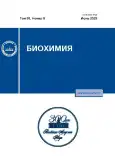Multiple non-canonical base-stacking interactions as one of the major determinants of RNA tertiary structure organization
- Authors: Metelev V.G1, Baulin E.F2, Bogdanov A.A1,3,4
-
Affiliations:
- Faculty of Chemistry, Lomonosov Moscow State University
- Institute of Mathematical Problems of Biology of the Russian Academy of Sciences - the Branch of Keldysh Institute of Applied Mathematics of Russian Academy of Sciences
- A. N. Belozersky Institute of Physico-Chemical Biology, Lomonosov Moscow State University
- Shemyakin-Ovchinnikov Institute of Bioorganic Chemistry
- Issue: Vol 88, No 6 (2023)
- Pages: 973-983
- Section: Articles
- URL: https://journals.rcsi.science/0320-9725/article/view/144301
- DOI: https://doi.org/10.31857/S0320972523060076
- EDN: https://elibrary.ru/EFLFMJ
- ID: 144301
Cite item
Full Text
Abstract
About the authors
V. G Metelev
Faculty of Chemistry, Lomonosov Moscow State University119991 Moscow, Russia
E. F Baulin
Institute of Mathematical Problems of Biology of the Russian Academy of Sciences - the Branch of Keldysh Institute of Applied Mathematics of Russian Academy of Sciences142290 Pushchino, Moscow Region, Russia
A. A Bogdanov
Faculty of Chemistry, Lomonosov Moscow State University;A. N. Belozersky Institute of Physico-Chemical Biology, Lomonosov Moscow State University;Shemyakin-Ovchinnikov Institute of Bioorganic Chemistry
Email: bogdanov@belozersky.msu.ru
119991 Moscow, Russia;119992 Moscow, Russia;117997 Moscow, Russia
References
- Fresco, J. R., Alberts, B. M., and Doty, P. (1960) Some molecular details of the secondary structure of ribonucleic acids, Nature, 188, 98-101, doi: 10.1038/188098a0.
- Spirin, A. S. (1960) On macromolecular structure of native high-polymer ribonucleic acid in solution, J. Mol. Biol., 2, 436-446, doi: 10.1016/S0022-2836(60)80054-X.
- Butcher, S. E., and Pyle, A. M. (2011) The molecular interactions that stabilize RNA tertiary structure: RNA motifs, patterns, and networks, Acc. Chem. Res., 44, 1302-1311, doi: 10.1021/ar200098t.
- Nissen, P., Ippolito, J. A., Ban, N., Moore, P. B., and Steitz, T. A. (2001) RNA tertiary interactions in the large ribosomal subunit: the A-minor motif, Proc. Natl. Acad. Sci. USA, 98, 4899-4903, doi: 10.1073/pnas.081082398.
- Klein, D. J., Schmeing, T. M., Moore, P. B., and Steitz, T. A. (2001) The kink-turn, EMBO J., 20, 4214-4221, doi: 10.1093/emboj/20.15.4214.
- Chawla, M., Chermak, E., Zhang, O., Bujnicki, J. M., Oliva, R., and Cavallo, L. (2017) Occurrence and stability of lone pair-stacking interactions between ribose and nucleobases in functional RNAs, Nucleic Acids Res., 45, 11019-11032, doi: 10.1093/nar/gkx757.
- Baulin, E., Metelev, V., and Bogdanov, A. (2020) Base-intercalated and base-wedged stacking elements in 3D-structure of RNA and RNA-protein complexes, Nucleic Acids Res., 48, 8675-8685, doi: 10.1093/nar/gkaa610.
- Dallas, A., and Moore, P. B. (1997) The loop E-loop D region of Escherichia coli 5S rRNA: the solution structure reveals an unusual loop that may be important for binding ribosomal proteins, Structure, 5, 1639-1653, doi: 10.1016/s0969-2126(97)00311-0.
- Cate, J. H., Gooding, A. R., Podell, E., Zhou, K., Golden, B. L., Kundrot, C. E., Cech, T. R., and Doudna, J. A. (1996) Crystal structure of a group I ribozyme domain: principles of RNA packing, Science, 273, 1678-1685, doi: 10.1126/science.273.5282.1678.
- Teplova, M., Malinina, L., Darnell, J. C., Song, J., Lu, M., Abagyan, R., Musunuru, K., Teplov, A., Burley, S. K., Darnell, R. B., and Patel, D. J. (2011) Protein-RNA and protein-protein recognition by DualKH1/2 domains of the neuronal splicing factor Nova-1, Structure, 19, 930-944, doi: 10.1016/j.str.2011.05.002.
- Leontis, N. B., and Zirbel, C. L. (2012) Nonredundant 3D structure datasets for RNA knowledge extraction and benchmarking, RNA 3D Structure Analysis and Prediction (Leontis, N., and Westhof, E., eds), Nucleic Acids and Molecular Biology, 27, 282-298, Springer-Verlag Berlin Heidelberg, doi: 10.1007/978-3-642-25740-7_13.
- Lu, X.-J., Bussemaker, H. J., and Olson, W. K. (2015) DSSR: an integrated software tool for dissecting the spatial structure of RNA, Nucleic Acids Res., 43, e142, doi: 10.1093/nar/gkv716.
- Shalybkova, A. A., Mikhailova, D. S., Kulakovskiy, I. V., Fakhranurova, L. I., and Baulin, E. F. (2021) Annotation of the local context of RNA secondary structure improves the classification and prediction of A-minors, RNA, 27, 907-919, doi: 10.1261/rna.078535.120.
- Yogesh, K., Gupta, Y. K., Nair, D. T., Wharton, R. P., Aggarwal, A. K. (2008) Structures of human Pumilio with noncognate RNAs reveal molecular mechanisms for binding promiscuity, Structure, 16, 549-557, doi: 10.1016/j.str.2008.01.006.
- Guogas, L. M., Filman, D. J., Hogle, J. M., and Gehrke, L. (2004) Cofolding organizes alfalfa mosaic virus RNA and coat protein for replication, Science, 306, 2108-2111, doi: 10.1126/science.1103399.
- Mondragón, A. (2013) Structural studies of RNase P, Annu. Rev. Biophys., 42, 537-557, doi: 10.1146/annurev-biophys-083012-130406.
- Krasilnikov, A. S., Xiao, Y., Pan, T., and Mondragón, A. (2004) Basis for structural diversity in homologous RNAs, Science, 306, 104-107, doi: 10.1126/science.1101489.
- Krasilnikov, A. S., Yang, X., Pan, T., and Mondragón, A. (2003) Crystal structure of the specificity domain of ribonuclease P, Nature, 421, 760-764, doi: 10.1038/nature01386.
- Reiter, N. J., Osterman, A., Torres-Larios, A., Swinger, K. K., Pan, T., and Mondragón, A. (2010) Structure of a bacterial ribonuclease P holoenzyme in complex with tRNA, Nature, 468, 784-789, doi: 10.1038/nature09516.
- Mignon, P., Loverix, S., Steyaert, J., and Geerlings, P. (2005) Influence of the π-π interaction on the hydrogen bonding capacity of stacked DNA/RNA bases, Nucleic Acids Res., 33, 1779-1789, doi: 10.1093/nar/gki317.
- Leontis, N. B., and Westhof, E. (2001) Geometric nomenclature and classification of RNA base pairs, RNA, 7, 499-512, doi: 10.1017/s1355838201002515.
- Noller, H. F., Donohue, J. P., and Gutell, R. R. (2022) The universally conserved nucleotides of the small subunit ribosomal RNAs, RNA, 28, 623-644, doi: 10.1261/rna.079019.121.
- Sergiev, P. V., Kiparisov, S. V., Burakovsky, D. E., Lesnyak, D. V., Leonov, A. A., Bogdanov, A. A., and Dontsova, O. A. (2005) The conserved A-site finger of the 23S rRNA: just one of the intersubunit bridges or a part of the allosteric communication pathway? J. Mol. Biol., 353, 116-123, doi: 10.1016/j.jmb.2005.08.006.
- Walkera, A. S., Russ, W. P., Ranganathanc, R., and Schepartza, A. (2020) RNA sectors and allosteric function within the ribosome, Proc. Natl. Acad. Sci. USA, 117, 19879-19887, doi: 10.1073/pnas.1909634117.
- Peselis, A., and Serganov, A. (2021) Cooperativity and allostery in RNA systems, Methods Mol. Biol., 2253, 255-271, doi: 10.1007/978-1-0716-1154-8_15.
Supplementary files










